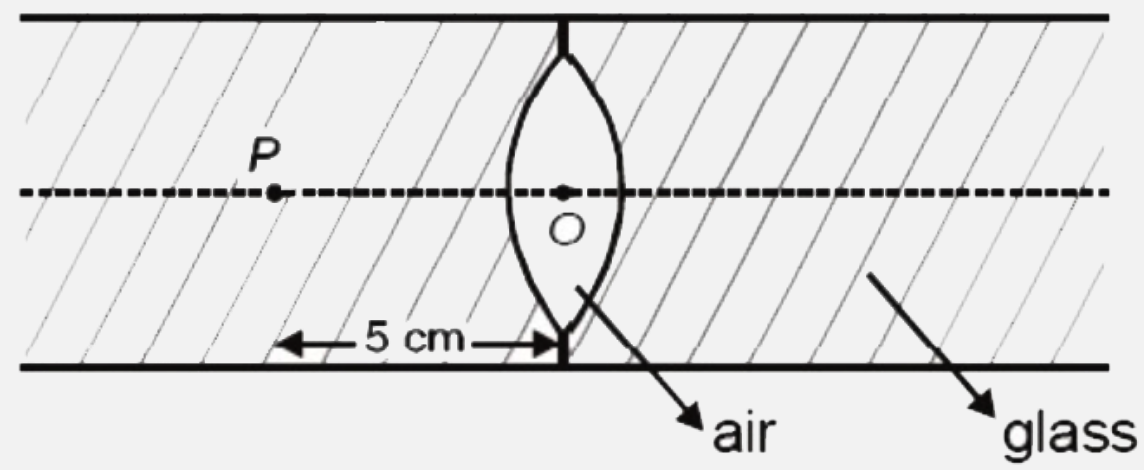Consider the show glass slab having a thin biconvex cavity of air centred at O. A black spot at P will have image ( μglass=32 ,the radius of curvature of each surface of the cavity = 10 cm)

7.5 cm on the right side of O
7.5 cm on the left side of O
3.75 cm on the right side of O
3.75 cm on the left side of O
The correct Answer is:D
Step by step video & image solution for Consider the show glass slab having a thin biconvex cavity of air centred at O. A black spot at P will have image ( mu_("glass") =3/2 ,the radius of curvature of each surface of the cavity = 10 cm) by Physics experts to help you in doubts & scoring excellent marks in Class 12 exams.
Updated on:21/07/2023Topper's Solved these Questions
Similar Questions
The figure below shows a thin plano-convex lens of refractive index μ1 and a thin plano-concave lens of refractive index μ2, both having same radius of curvature R of their curved surfaces. Another thin lens of refractive index μ3 has same radius of curvature R on the two surface between the plano-convex and plano-concae lenses that the plane surfaces are parallel to each other. Find the focal length of the combination.

View SolutionThe adjacent figure shows a thin plano-convex lens of refractive index μ1 and a thin plano-concave lens of refractive index μ2, both having same radius of curvature R of their curved surfaces. The thin lens of refractive index μ3 has radius of curvature R of both its surfaces. This lens is so placed in between the plano-convex and plano-concave lenses that the plane surfaces are parallel to each other.
The focal length of the combination is

View Solution
Knowledge Check
A long glass rod has a hemispherical end. A narrow beam of light is incident on the spherical end, the beam being parallel to the length of the rod. What is the position of the image formed if the refractive index of glass is 1.5 and the radius of curvature of the spherical surface is 10 cm ?
Av = 30 cm in airBv = 20 cm in airCv = 30 cm in glassDv = 50 cm in glassAn image is formed at a distance of 100 cm from the glass surface with refractive index 1.5, when a point object is placed in the air at a distance of 100 cm from the glass surface. The radius of curvature is of the surface is
A20 cmB40 cmC30 cmD50 cmA beam of light coming from infinty is passing through a biconvex lens having radius of curvature R=20cm of each surface, if focused at a certain distance from lens. Find the radius of curvature of emergent wave front from lens : (μ≤ns=1.5)
A10cmB5cmC1cmD20cm
A double-convex lens is to be made of glass with an index of refraction of 1.5. One surface is to have 2 times the radius of curvature of the other and the focal length is to be 60mm. What is the (a) smaller and (b) larger radius?
View SolutionShow that for refraction at a concave spherical surface (separating glass-air medium), the distance of the object should be greater than three times the radius of curvature of the refracting surface for the image to be real.
View SolutionA point source (A) is kept on the axis of a hemi- spherical paperweight made of glass of refractive indexμ=32 . The distance of the point source from the centre (O) of the sphere is R where R is radius of the hemisphere. Use paraxial approximations for answering following questions (a) Find the change in radius of curvature of the wave- fronts just after they enter the glass at O. (b) Find the radius of curvature of the wavefronts at point P just outside the glass.

View SolutionA spherical surface of radius of curvature R separates air (refractive index 1.0) from glass (refractive index 1.5). The centre of curvature is in the glass. A point object P placed in air is found to have a real image Q in the glass. The line PQ cuts the surface at a point O, and PO=OQ. The distance PO
View SolutionA point object O is placed in front of a glass rod having spherical end of radius of curvature 30cm. The image would be formed at

View Solution
